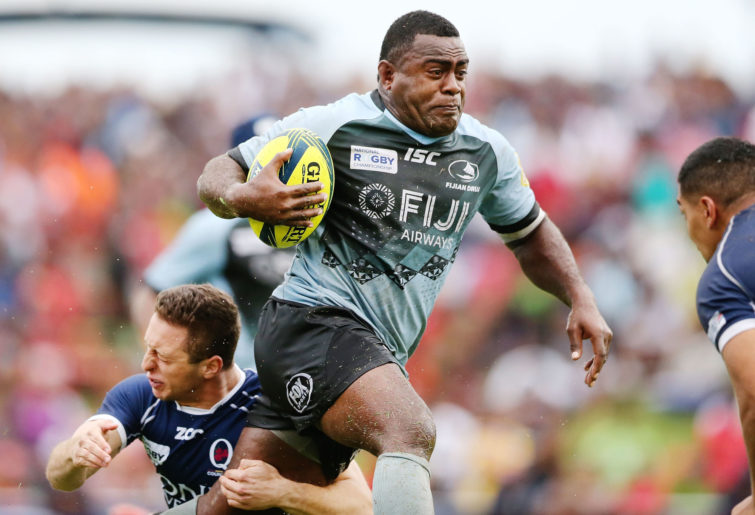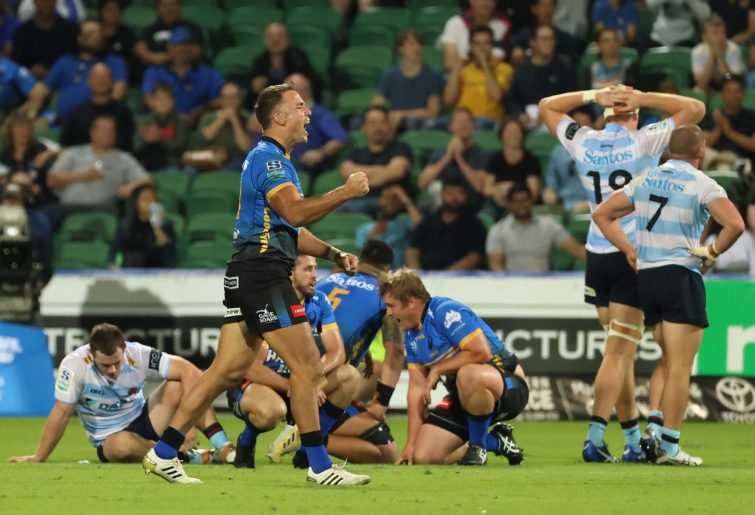It is commonly accepted that the well-known saying “the devil is in the detail” was derived from an earlier German phrase, “god is in the detail.”
And no, don’t panic, you can get your Israel Folau fix every Friday, like clockwork, over at the Australian.
The announcement last week that New Zealand Rugby has conditionally awarded licences to Moana Pasifika and the Fijian Drua to enter Super Rugby in 2022 has been met with almost universal joy and acclaim.
And why not? It’s almost impossible to find anyone who doesn’t think that there are wrongs to be righted and improving pathways for Pacific Islands players into professional rugby is a good idea.
But this is one of those cases where, when the initial euphoria dies off, and after Rugby Australia rubber stamps things from their side, the detail is going to prove critically important.
On Friday, Stan/Nine media’s Morgan Turinui warned that this move couldn’t be allowed to provide a mechanism for New Zealand to create for itself an extra feeder team for the All Blacks at the expense of Samoa and Tonga. This concern exists because Moana Pasifika is expected to be based in South Auckland, and does not have the same obvious tie to a national union as the Drua does to Fiji.
But pivotal figures, Sir Michael Jones and Sir Bryan Williams, have made it clear that the whole point is to provide an avenue into professional franchise rugby for Islander players, and to bolster their presence in Test rugby. Also, there is no indication that New Zealand Rugby is seeking to change its policy of only selecting All Blacks from its own five franchise teams, regardless of where Moana Pasifika is based.
The real concerns lie elsewhere. One of the compelling features of Super Rugby Aotearoa and, increasingly, Super Rugby Australia, is the high number of competitive matches and close, tense finishes. Any new venture has to start somewhere, and build foundations for future success, but fans and broadcasters have shown in recent years that tolerance for one-sided matches is low.
No matter the lurking talent, the step up to Super Rugby is huge. It is hard to imagine either side being ready for this in the early stages. Make no mistake, the most important person in each of these new franchises, will be the recruitment and list manager.

Ratunaisa Navuma of Fijian Drua in the NRC. (Photo by Anthony Au-Yeung/Getty Images)
The other major concern rests with an issue few seem prepared to talk about. The Blues have been an underperforming franchise for too many years to remember, and perhaps after their ill-disciplined 35-29 loss to the Highlanders on Friday night, many would say they still are.
Just like concerns over the Waratahs in Australia, it serves rugby no good for the largest, most populous cities to have their sides missing from the pointy end of the competition for too long.
Strong recruiting, improved performances and a public willingness to push back against Covid has seen the Blues’ supporter base regenerate over the last two seasons. But with many of their fans being of Pacific Island heritage, the Blues administration now finds itself in another battle to sustain momentum and retain the hearts and minds of their own supporters; many of whom are itching to align themselves with the new franchise.
Even if they end up being based in Western Sydney, the Drua are undeniably a Fijian side. But more than 200,000 Polynesians, the vast majority Samoan and Tongan, make up roughly 15 per cent of Auckland’s population. The identity and culture of this team will be drawn from Samoa, Tonga and Auckland, the largest Pasifika city in the world.
And why wouldn’t fans want to attach themselves to the new team? Anyone who watched Tonga progress through the last Rugby League World Cup, and marvelled at the atmosphere created by the sea of red would rightly be salivating at the prospect of more of the same.
But in doing so, let’s spare a thought for the Blues, who, while everyone else rejoices, now have to figure out how to digest the fecal sandwich they’ve just been served up.
The Brisbane ghost of Scott Barrett was revisited in Dunedin on Friday, when the Blues’ Hoskins Sotutu was sent to the sin bin on a TMO review for foul play, after tickling the ball out of Josh Dickson’s hands with his foot, while laying on the ground.
Whatever the merits of the penalty, it feels like it’s time for the game to clarify the parameters within which TMO’s operate. The definition of ‘foul play’ comprises five sub-categories; obstruction, unfair play, repeated infringements, dangerous play and misconduct.
If rugby wants cynical acts carried out on the bottom of a ruck rubbed out of the game, is the game prepared to have all of those acts dealt with by the TMO? Last weekend, Liam Wright’s actions at the end of the Reds versus Brumbies match fell into the same category as Sotutu, yet there was no TMO intervention.

Liam Wright of the Reds (Tracey Nearmy/Getty Images)
Are fans prepared to have matches grind to a halt while the TMO reviews every high kick to see if a defending player has altered their line to block a chaser?
Which ones does the TMO involve himself in? It surely has to be all of them, or none of them. Or is it just the ones like where the wily, experienced Aaron Smith cleverly drew Sotutu’s boot to the attention of the TMO without using his captain’s challenge?
Only in the ‘red zone’ I hear some people say. What’s that exactly? Ten metres out from the try line? In the attacking 22? Within kicking distance? Whose kicking distance? Jordie Barrett’s or Cabous Eloff’s?
Move forward to Saturday where it was Scott Barrett himself who, with his side down by two points and time almost up, lodged a captain’s challenge to determine if a steal by the Chiefs’ Naitoa Ah Kuoi was made lawfully.
Forget about the challenge being unsuccessful for a moment. What if Ah Kuoi had momentarily brushed the ground with his hand before latching on to the ball? Despite his actions having being seen in real time by the referee and rewarded.
Would slow motion evidence of Ah Kuoi’s hand touching the ground have been enough for the TMO rule a penalty and hand the Crusaders the win?
Are TMO’s now in a similar position to a third umpire in cricket, trying to determine if a catch has been taken without the ball momentarily touching the ground? Is this how we want matches decided?
Surely it isn’t. Barrett himself has said he doesn’t like it. This kind of detail is indeed the devil.
By all means use the TMO for dangerous play, to keep the high and late niggle merchants out of the game. But as for the rest of it? Let’s let the referees get on with doing their job, without second guessing them, and get off the NFL pathway of officiating the match on replay, before it’s too late.
Thankfully the quality of the rugby and the evenness of the contests was once again enough to override concerns, with the Chiefs leap-frogging the Blues into second place in the Aotearoa competition.

(Photo by Fiona Goodall/Getty Images)
There was so much to like from both matches.
There was the massively improved ball security of the Highlanders, the thirst that Shannon Frizell has developed for hard work on both sides of the ball, the bravery and execution on the tackle of Josh Ioane and Mitch Hunt, Jonathan Ruru expertly picking off Smith early, but Smith recovering to spark his side, and Caleb Clarke recapturing his running form, before unfortunately blotting his copybook by lazily failing to get back and cover a Hunt touch-finder right on halftime, which compounded into a try conceded from the lineout.
In Hamilton there was the youthful exuberance of locks Ah Kuoi and Tupou Vaa’i, the bullocking presence of hooker Samisoni Taukei’aho, and Damian McKenzie, as ever, stamping his mark all over Super Rugby.
The Crusaders, a handful of men off their best, struggled to bring George Bridge and Sevu Reece into the game, and paid dearly for Mo’unga missing an easy conversion, but it is far from panic stations for the champions just yet.
In a Saturday night thriller in Perth, there was a heartbreaking devil in the detail of the Waratahs’ final lineout. Needing only to hit a jumper to secure possession and their first win, the visitors got both their call and throw wrong, allowing the Force to probe for twenty phases before securing the penalty that gave them a dramatic 31-30 victory.
To add salt for the Waratahs, the final lineout might never needed to have happened, with referee Amy Perrett, on the advice of her assistant, blowing an offside penalty to the Waratahs while they were in possession, thus denying them advantage, and the opportunity to run down the clock.
That fourth versus fifth could put on such an entertaining and exciting contest is another measure of how far Super Rugby AU has progressed in two seasons. This was a result Perth fans and hard-working hooker Feleti Kaitu’u deserved, and the sea of blue will be swarming again next week to see if their side can upset the Reds to earn themselves a play-off final in Canberra.

(Photo by Paul Kane/Getty Images)
A war of words erupted last week in Sydney, with Eastwood coach Ben Batger describing the selection of flyhalf, Ben Donaldson, as “crazy”. Crazy good was one way to describe how Donaldson dealt with the ball falling off a recalcitrant tee, drilling a hurried drop goal conversion from wide out
There was more than perfect goalkicking in Donaldson’s locker – soft hands and a willingness to play flat at the line – and with Jake Gordon and Izaiah Perese highly competitive, things look far brighter for the Waratahs than may have appeared a month ago.
Sunday’s match was also in the balance after the siren, but the Rebels’ late push was stymied by their inability to recycle quickly and cleanly. After a strange first half in which not a lot of football was played, the game sprang to life in the second, with the Rebels encouraged by the long-awaited returns of Cameron Orr and Isi Naisarani.
Once again, the margins were fine, Eloff electing not to intercept the final pass to prevent Bayley Kuenzle’s try, thinking he was offside when he wasn’t. With Dane Haylett-Petty also due to return next week, the Rebels, assuming the Reds do them a favour and beat the Force, will have a great opportunity to secure a repeat final.
That would entail a visit to Canberra, to face a rested Brumbies, coach Dan McKellar explaining after the match how the break has come at a good time for his team, and that the rest and extra preparation time will be welcomed.
Finally this week, news is filtering through of a tournament planned for October, potentially to be held in Adelaide, comprising the ‘minor’ states and country New South Wales and Queensland.
In the absence of the NRC, this is effectively a renewal of the Australian Rugby Shield, last sighted in 2008. Eligible players will come from club rugby, the idea being to provide an upwards pathway, rather than fill the teams with contracted Super Rugby players.
More information will no doubt be forthcoming, but don’t expect any devil in this detail. Anything that heightens interest in domestic rugby and provides opportunity for players to bridge the gap between club and professional rugby should be welcomed.
































































































